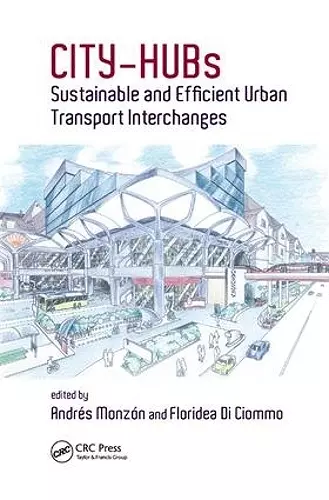CITY-HUBs
Sustainable and Efficient Urban Transport Interchanges
Andres Monzon-de-Caceres editor Floridea Di Ciommo editor
Format:Paperback
Publisher:Taylor & Francis Ltd
Published:11th Jan '19
Currently unavailable, and unfortunately no date known when it will be back
This paperback is available in another edition too:
- Hardback£195.00(9781498740845)

Explore the Design and Operation of Urban Transport Interchanges
Transport planners throughout the world can implement a range of policies to influence travelers’ behavior, and encourage a move to public transport to achieve urban sustainability and social inclusion. At the same time population growth and urban sprawl exert their own pressures. Quality, accessible and reliable public transport through intermodal trips provides a solution. More than 20% of current commuting trips in Europe are intermodal, and typically between 20% and 30% of trip time is spent in intermodal transfer. Interchange stations are becoming important parts of city infrastructure where people spend time on social or economic activities.
Includes Contributions from Numerous Experts in the Field
CITY-HUBs: Sustainable and Efficient Urban Transport Interchanges focuses on urban transport interchanges from more than 20 European researchers demonstrates why transport interchanges are crucial for a seamless public transport system. It is based on a broad consultation process to stakeholders of 26 interchanges in 10 different countries, and on tailored surveys to travelers in five of them. It shows travelers how to reduce the negative aspects of transfer by improving information provision and by delivering convenient services and facilities.
The book outlines the required steps from interchange planning to operation, and defines the functions, the design of the space for transfer, stay and services, and assesses the needs for different types of interchange. It introduces the evaluation of urban and economic impacts and the identification of users’ perceptions to improve interchange efficiency. The most important factors from the user point of view are safety and security, transfer conditions, information, design, services and facilities, environmental quality and comfort. These define the efficiency of the interchange from two different perspectives: as a transport node and as a place.
Packed with relevant data and offering step-by-step instruction, this book:
- Proposes innovative operating strategies for an intermodal services organization (i.e. innovative business model)
- Explores pilot and test case studies for defining interchanges good practice, and tests them in validation case studies
- Sets out urban planning guidelines for urban integration of a transport interchange
As an advanced guide CITY-HUBs: Sustainable and Efficient Urban Transport Interchanges caters to transport operators, authorities, end-users’ organizations and policy makers who are challenged to implement new urban interchanges or to upgrade them.
"This book deals with an issue that is paramount in succeeding the shift towards better mobility practices. Better, in this context, means both user-friendly and environment-friendly mobility. Interchanges play a major role to achieve this goal. And this is precisely the scope of this book."
—Dr. Panos Tzieropoulos, EPFL - École polytechnique fédérale de Lausanne, Switzerland
"An essential reference for understanding the potential for developing the role of interchanges in different spatial contexts and for establishing consistent levels of quality, accessibility and service provision internationally."
—Iqbal Hamiduddin, The Bartlett School, UCL, London,
"Instead of being limited to specific mobility concerns, the comprehensiveness of the city-hub vision is explicit in its interdisciplinary approach to a wide spectrum of elements and issues, including governance (stakeholders, management, finance and business strategies), technological innovation, social concerns (inclusiveness and accessibility), urban land use planning and environment… a timely and useful publication to address the issues of urban interchanges by proposing a holistic and interdisciplinary "business model" approach."
-- Chia-Lin Chen, Journal of Transport Geography
ISBN: 9780367138981
Dimensions: unknown
Weight: 453g
280 pages